ChessBase Magazine #177
Review by Nagesh Havanur
ChessBase Magazine #177 (DVD + Booklet)
Languages: English, German
Delivery: Download, Post
Level: Any
Price: €19.95 – €16.76 or $18.10 without VAT (for customers outside the EU)
Tan Zhongyi who was crowned Women’s World Champion this year has graced the cover of this issue. It also carries all the games from the event. As is known, the contest for the title was marred by controversy. However, that should not detract from the extraordinary effort that the players made to win and qualify round after round in this knockout event.
Perhaps the toughest encounter was the last round between Tan Zhongyi and Anna Muzychuk. In this issue the game is annotated by GM Moradiabadi. Here I shall limit myself to the final phase that proved decisive.
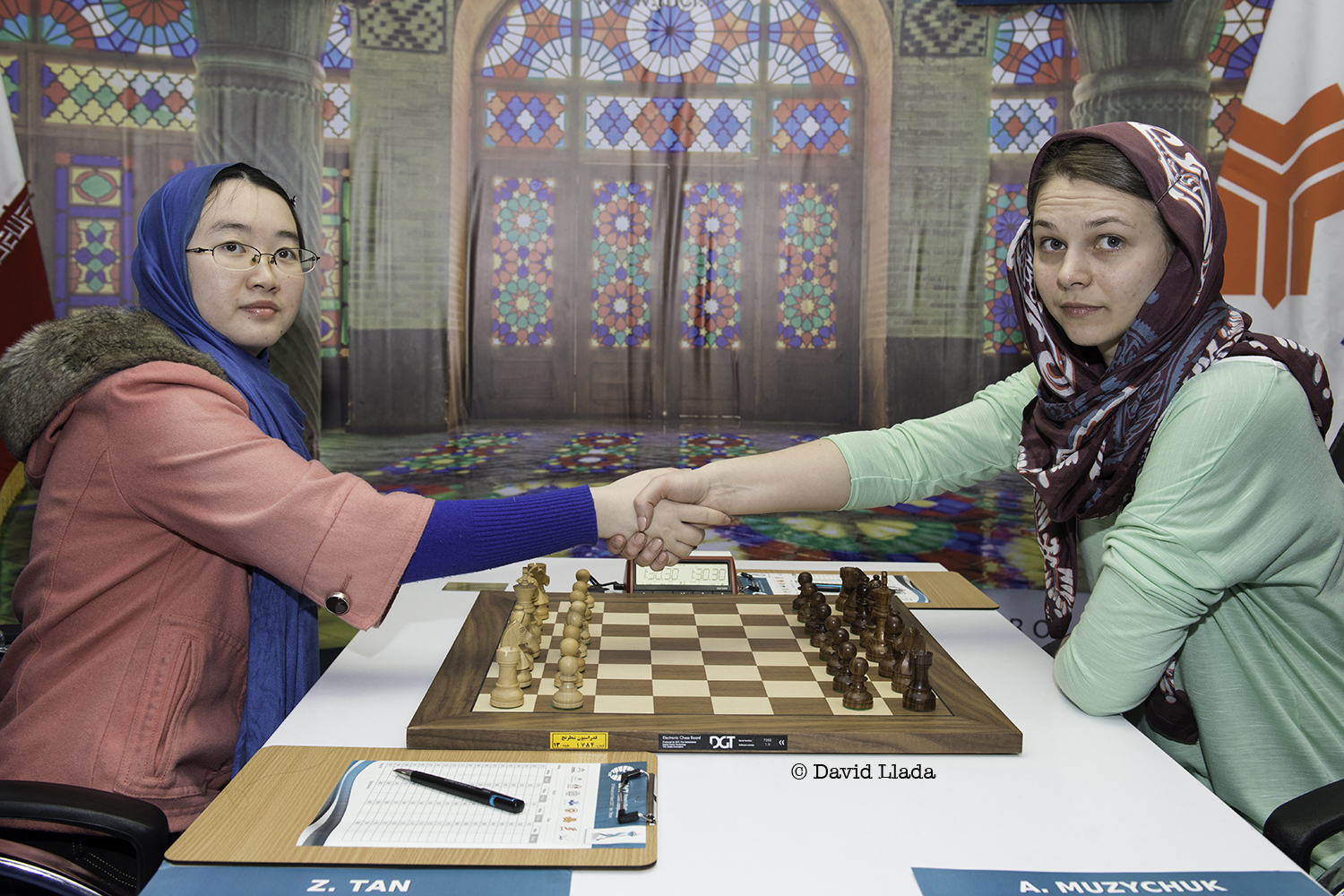

[Event "Women's World Championship"] [Site "?"] [Date "2017.03.03"] [Round "?"] [White "Tan, Zhongyi"] [Black "Muzychuk, Anna"] [Result "1-0"] [Annotator "Nagesh Havanur"] [PlyCount "83"] [EventDate "2017.??.??"] 1. d4 d5 2. c4 c6 3. Nf3 Nf6 4. g3 Bf5 5. Nc3 e6 6. Nh4 dxc4 7. Nxf5 exf5 8. e3 Nbd7 9. Bxc4 Nb6 10. Be2 Bd6 11. Bf3 O-O 12. O-O Re8 13. Qc2 Qd7 14. b3 Re7 15. Na4 Rae8 16. Nc5 Qc8 17. Bd2 Nbd5 18. Rac1 Ne4 19. Bg2 g6 20. b4 Qc7 21. Nxe4 fxe4 22. b5 Ba3 23. Rb1 cxb5 24. Qb3 Qd6 25. Qxb5 Rc8 26. Qb3 Kg7 27. Bc1 Bxc1 28. Rbxc1 Rc6 29. Rxc6 Qxc6 30. Qa3 Qb6 31. Rc1 {[#]} Qb4 {A dangerous gamble. Moradiabadi rightly questions this move.} ({It didn't hurt to play} 31... a6 { If} 32. Rc5 Qb1+ 33. Bf1 Rd7) 32. Qxa7 Nc3 {He is also critical of this move. However, the move is not without merit. Black gains tempo targeting both the a-pawn and the rook. The knight also releases the castle from defending the pawn on e4.} 33. Rf1 $6 {seeking safety first} (33. Re1 $4 {loses to} Nb5 $19) (33. Bf1 $2 {costs the exchange after} Rc7 $1 34. Kg2 Nb5 35. Bxb5 Rxc1) ({ If White wanted more, he had to try} 33. a3 $1 Qb2 34. Rf1 {with favourable chances, though much play is left in the position after} Qb5 ({or} 34... Re6 35. Qc5 b6 36. Qb4 Qxb4 37. axb4 $14)) 33... Qc4 $2 {A plausible move targeting the a-pawn and also making way for his b-pawn. However, it allows the White queen to re-enter the diagonal and invade dark squares with great effect.} ({Moradiabadi recommends} 33... b5 $1 {Now} 34. Qa8 {appears intimidating as neither the knight nor the rook can move away without losing the e-pawn. However, Black has the saving move} Qa4 $1 35. Qxa4 bxa4 $11) 34. Qa3 $1 Re6 35. Re1 Ra6 36. Qe7 Rxa2 $6 {Rushing to make it to the time control. But the e-pawn is too important to lose.} ({Moradiabadi again gives} 36... b5 $1 {Here Black will have to tread carefully.} 37. Qe5+ ({not} 37. Bxe4 $4 Re6 $19) 37... Kg8 38. d5 $1 Nxd5 (38... Rxa2 39. d6 Ne2+ 40. Kh1 Qc3 41. Qe8+ Kg7 42. Rf1 Qf6 43. Qxb5 {is rather dangerous.}) 39. Rd1 Nf6 40. Bf1 Qxa2 41. Bxb5 Rb6 42. Qc5 Ng4 43. Qc8+ Kg7 44. Qxg4 Rxb5 45. Qxe4 Rb2 46. Rf1 $14) 37. Bxe4 $6 (37. Qxb7 $1 {would have precluded the counterplay that followed with the advance of the b-pawn.}) 37... b5 38. Bf3 b4 $2 {"This move allows a dangerous check" -Moradiabadi} ({Instead he suggests} 38... Qe6 39. Qb4 Qf6 40. Qxc3 Qxf3 41. Rf1 Qd5 {with good drawing chances.}) 39. Qe5+ Kh6 $4 (39... Kg8 $1 { would have prolonged resistance, though the advance of White's d-pawn would have outweighed any chances of Black with his b-pawn.}) 40. g4 $1 f6 41. Qxf6 Ra5 42. h4 {and a despairing Muzychuk resigned.} 1-0
A traumatic defeat for Anna Muzychuk! However, Tan Zhongyi held steady nerve that enabled her to win.
In retrospect I think it’s time to have a level playing field for men and women in chess. There is plenty of chess talent among the latter and as long as it is confined to “girls only” events, it would have a stunted growth. Let parents encourage their daughters to play in open contests with boys, and in course of time they would be following the footsteps of Judit Polgar.
This brings me to tournament games in the magazine. Among others they cover battles from Wijk aan Zee, Gibralter and FIDE Grand Prix events. As is known, the Wijk aan Zee Tournament was won by Wesley So ahead of Carlsen with a half point margin. Magnus had the discomfiture of being beaten by Richard Rapport (an elegant performance annotated by Aleksandr Lenderman in this issue). Rapport who finished at the bottom of the tournament table also had the distinction of playing the craziest game of the tournament with Wesley So. Here I shall limit myself to one line pointed out by the commentator in this issue.

[Event "79th Tata Steel GpA "] [Site "?"] [Date "2017.01.16"] [Round "?"] [White "So, W."] [Black "Rapport, R."] [Result "1-0"] [ECO "E18"] [WhiteElo "2808"] [BlackElo "2702"] [Annotator "Nagesh Havanur"] [PlyCount "95"] [EventDate "2017.??.??"] 1. Nf3 Nf6 2. g3 b6 3. d4 Bb7 4. c4 e6 5. Bg2 Be7 6. O-O O-O 7. Nc3 Ne4 8. Bd2 Bf6 9. Rc1 Nxd2 10. Qxd2 d6 11. d5 e5 12. e4 Nd7 13. h4 a5 14. Bh3 Nc5 15. Kg2 Bc8 16. Rh1 Bxh3+ 17. Rxh3 Qd7 18. Nh2 h5 19. f3 g6 20. g4 Kh7 21. Rh1 Rg8 22. Qd1 Bg7 23. Nf1 Bh6 24. Kf2 Bc1 25. Ng3 Bxb2 26. Nb5 Bc1 27. gxh5 Bf4 28. Nc3 f5 29. hxg6+ Rxg6 30. Nxf5 Rag8 31. Kf1 b5 32. cxb5 Rg2 33. Qb1 {[#]} Qf7 ({ Now the clinical} 33... Rd2 $1 {followed by the invasion by the rook or the knight would have won as pointed out by many commentators.}) ({In this magazine Igor Stohl offers one more possibility.} 33... c6 $5 34. b6 (34. dxc6 Qa7 35. b6 Qa6+ 36. Qb5 Qxb5+ 37. Nxb5 Nd3 $19) 34... Qb7 {followed by ...Qa6 winning. That's more aesthetically pleasing.}) 34. Ne2 Qg6 35. Ne7 Rf2+ 36. Kxf2 Qg2+ 37. Ke1 Rg3 38. Rxg3 Qxh1+ 39. Rg1 Qxf3 40. Nxf4 Qe3+ 41. Ne2 Nd3+ 42. Qxd3 Qxd3 43. Ng8 Qf3 44. h5 Kh8 45. Rg6 Qh1+ 46. Kd2 Qxe4 47. Nf6 Qb4+ 48. Ke3 1-0
A terrific essay in tactical fantasy that failed to meet the reality test! M. Tal would have sympathized. Igor Stohl has analysed the game in great depth in this issue. Danny King has also made a video presentation of the same. What we have seen here is the proverbial tip of the iceberg.
This brings me to other sections of the Magazine. There are eleven opening surveys ranging from the Sicilian to the Slav. For a change I would mention the survey by Michal Krasenkow on an unorthodox line in the English Opening: 1.Nf3 Nf6 2.c4 c5 3.Nc3 d5 4.cxd5 Nxd5 5.e4 Nb4 6.Bc4 Be6 (A34)
White’s opening play circumvents Black’s attempt to initiate the Grünfeld with 3…d5 followed by…g6, Bg7 and 0-0. Is it worth it? Krasenkow shows how White can run into some serious danger with this line. I have simplified his analysis for younger readers unfamiliar with theory and also indicated improvements for White

[Event " "] [Site "?"] [Date "????.??.??"] [Round "?"] [White "Avoiding Grünfeld"] [Black "English Opening"] [Result "*"] [ECO "A34"] [Annotator "Nagesh Havanur"] [PlyCount "38"] 1. Nf3 Nf6 2. c4 c5 3. Nc3 d5 4. cxd5 Nxd5 5. e4 {A move introduced by Aron Nimzowitsch.} (5. d4 Nxc3 6. bxc3 g6 7. e4 {leads to regular Grünfeld lines.}) 5... Nb4 (5... Nxc3 6. dxc3 Qxd1+ 7. Kxd1 {favours White according to theory.}) 6. Bc4 (6. d3 Bg4 7. Be3 e6 8. Rc1 N4c6 $11 {is said to be innocuous. However, the fight is still ahead.} ({Not} 8... N8c6 9. a3 Na6 {and the knight is out of play.})) (6. Bb5+ N8c6 7. O-O {deserves attenion-NSH}) 6... Be6 {This move pioneered by Kurt Richter way back in 1930 deserves a revival according to Michal Krasenkow.} (6... Nd3+ 7. Ke2 Nf4+ 8. Kf1 Ne6 {is in vogue.}) 7. Bxe6 ( 7. Bb5+ N8c6 {should be OK for Black.}) 7... Nd3+ ({After} 7... fxe6 8. O-O { White has easier development-NSH}) 8. Kf1 fxe6 9. Ng5 Nc6 $5 $146 {sacrificing a pawn for initiative} (9... Qd7 {is the older line.} 10. Qg4 (10. Qf3 { is met by} Ne5) 10... Nc6 11. Qxe6 (11. Nxe6 $2 {loses to} Nd4 12. Nxg7+ Bxg7 13. Qxg7 O-O-O $19) 11... Qxe6 12. Nxe6 Kd7 13. Ng5 ({Not} 13. Nxf8+ $2 Rhxf8 14. f3 Nd4 15. Ne2 Nxf3 $1 $17) 13... Nd4 $44) 10. Nxe6 Qd7 11. Nd5 {This side line may help White to make a safe landing.} ({The main line of Krasenkow's analysis runs} 11. Nxc5 Nxc5 12. Qh5+ g6 13. Qxc5 e6 14. Qc4 ({Or} 14. Qb5 a6 15. Qe2 Bc5 16. d3 O-O $1 $44) 14... Bg7 15. h4 O-O 16. Rh3 Nd4 $44) 11... Rc8 12. Qh5+ ({The more obvious} 12. Qg4 $2 {fails to} Nd4 13. Nxg7+ Bxg7 14. Qxg7 Rf8 15. f3 Qe6 $1 16. Qxh7 Rf7 17. Qh4 Qa6 $19) 12... g6 13. Qh3 c4 14. b3 Nd8 15. bxc4 $1 ({Better than} 15. Nxd8 Qxh3 16. gxh3 Rxd8 $17) 15... Nxc1 16. Nxd8 Qxh3 17. gxh3 Rxd8 18. Rxc1 e6 19. Nc7+ Ke7 $44 *
A minefield for White! However, if he survives, it does not look so bad in the end. Here I would put more emphasis on the side lines of Krasenkow’s analysis. White can transpose to the Grünfeld with 5.d4 as suggested by him. Or he can try 6.Bb5+Nbc6 7.0-0, a line that is less explored.
Apart from these surveys, there are regular exercises in opening traps, middle game tactics and endgame technique. Here I would single out Mihail Marin’s essay on the move …d6-d5, Black’s breakthrough in the Spanish with illustrative examples from great masters of the opening.
In all there are 2284 OTB games of which 149 are annotated. Commentators include Wesley So, Levon Aronian and Mihail Marin among others. I missed Telechess section. Hopefully, the grandmasters would be back next time to present games from correspondence chess.
Recommended – more info on the DVD is here
 The editor’s top ten
The editor’s top ten
- Finally winning Wijk! Wesley So presents his game against Wojtaszek and explains why victory in the classic tournament in the Netherlands was so important to him.
- An “oddball” idea: Levon Aronian explains how with 8.Na3 in the Catalan he achieved a brilliant win against Giri.
- French aggression: attack together with Simon Williams "Move by Move“ – just like Ju Wenjun did in her victory over Hou Yifan!
- Spanish temptation: let Rainer Knaak show you how to entice your opponent into the 7.Ng5 trap with 6...d7-d6.
- “Raving Rooks”: along with Oliver Reeh light some tactical fireworks with double threats and multi-purpose moves (interactive video).
- For and against the Bogo-Indian: GM Postny sums up the trends of recent years and shows you what is at present recommended.
- "Portuguese Scandinavian": let Petra Papp show you how best to meet the gambit 1.e4 d5 2.exd5 Nf6 3.d4 Bg4.
- A "mad way to win“: Anish Giri explains how he got Andreikin into trouble with the Scotch and what brilliant engine move he missed at the end.
- Fantastically shattered: enjoy Rapport's brilliancy against So in Daniel King’s video analysis.
- Surprise in the Queen’s Indian: let top Swiss player Yannick Pelletier unravel Aronian's 9.Be1 (video).
All opening articles in ChessBase Magazine #177
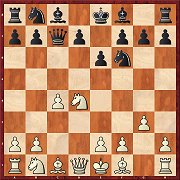 |
Lampert: English A32 (Recommendation for White)
1.d4 Nf6 2.c4 c5 3.Nf3 cxd4 4.Nxd4 e6 5.g3 Qc7
In this variation, classified under the English Opening, but more likely having arisen from a Declined Benoni, White usually sacrifices his c4-pawn. As Jonas Lampert demonstrates in his article, in return he obtains compensation or even something more. |
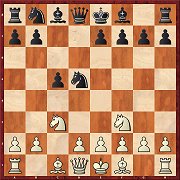 |
Krasenkow: English A34 (Recommendation for Black)
1.c4 c5 2.Nf3 Nf6 3.Nc3 d5 4.cxd5 Nxd5
As Michal Krasenkow explains, every fan of the Grünfeld has to be prepared for White choosing a different starting move order and delaying d2-d4 so as not to allow an original Grünfeld. One of these variations is the subject of the present article by our Grünfeld expert. |
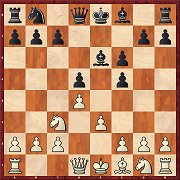 |
Moskalenko: Dutch Defence A80 (Recommendation for Black)
1.d4 f5 2.Nc3 d5 3.Bg5 Nf6 4.Bxf6 exf6 5.e3 Be6
Many completely avoid the position in the diagram (see Part 2 in CBM 172). But nowadays the variation is dealt with slightly differently: above all c7-c6 is absolutely avoided. Viktor Moskalenko evaluates the ensuing positions as slightly static but very playable for Black. |
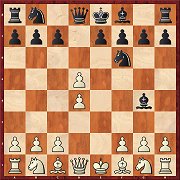 |
Papp: Scandinavian Defence B01 (Recommendation for White)
1.e4 d5 2.exd5 Nf6 3.d4 Bg4
Petra Papp has against the Portuguese Variation 3...Bg4 a clear plan which gives White an advantage in all lines. The very starting move 4.Bb5+ is in her opinion somewhat more accurate than the popular 4.f3. |
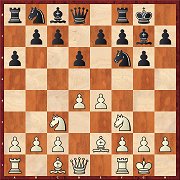 |
Breutigam: Pirc Defence B08 (Recommendation for Black)
1.e4 d6 2.d4 Nf6 3.Nc3 g6 4.Nf3 Bg7 5.Be2 0-0 6.0-0 a6
The move 6...a6 in the Pirc Defence has been known for a long time, but now this interesting variation has been enriched by remarkable facet: the idea, after Nb8-c6 followed by d4-d5, of retreating with the knight to a7. Martin Breutigam is enthusiastic about it. |
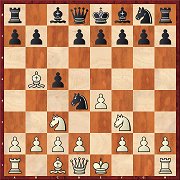 |
Petrov: Sicilian Defence B23 (Recommendation for White)
1.e4 c5 2.Nc3 Nc6 3.Bb5 Nd4 4.Nf3
As Marian Petrov explains in his article, the whole variation is above all based on the fact that by playing the “natural” 4...Nxb5 Black brings difficulties down on his own head, because White takes advantage of his lead on development for a rapid d2-d4. |
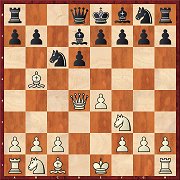 |
Szabo: Sicilian Defence B53 (Recommendation for Black)
1.e4 c5 2.Nf3 d6 3.d4 cxd4 4.Qxd4 Nc6 5.Bb5 Bd7
The Hungarian Variation 4.Qxd4 is employed above all to avoid the Najdorf System. Krisztian Szabo presents a plan for Black with which he obtains at least a level game against both 6.Bxc6 and the recently popular 6.Qd3. |
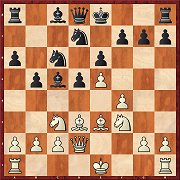 |
Ris: French Defence C11 (Recommendation for White)
1.e4 e6 2.d4 d5 3.Nc3 Nf6 4.e5 Nfd7 5.f4 c5 6.Nf3 Nc6 7.Be3 a6 8.Qd2 b5 9.dxc5 Bxc5 10.Bd3
As Robert Ris explains, the main idea behind Karjakin’s 10.Bd3 Qb6 11.Bf2! is above all that Black will have a few difficulties in the possible endgames. There may be quite good alternatives, but they too are not very easy to play. |
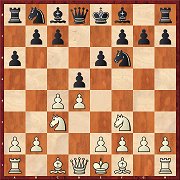 |
Kuzmin: Queen's Gambit D37 (Recommendation for Black)
1.d4 d5 2.c4 e6 3.Nf3 Nf6 4.Nc3 a6
Facing the unusual 4...a6 White mainly transposes with 5.cxd5 exd5 6.Bg5 to an Exchange Variation. As Alexey Kuzmin shows in his article on the DVD, Black develops with 6...Be6 and obtains very playable positions, though perhaps not complete equality. |
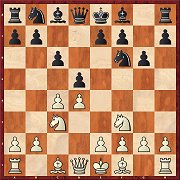 |
Marin: Slav/Grünfeld D90 (Recommendation for Black)
1.d4 d5 2.c4 c6 3.Nf3 Nf6 4.Nc3 g6
The relationship to the Schlechter Defence cannot be missed, but White has not yet played e3 and has some additional possibilities. But as Mihail Marin demonstrates, there is no need for Black to fear these, though knowledge of the Grünfeld is required. |
 |
Stohl: Catalan E06 (Recommendation for both sides)
1.d4 Nf6 2.c4 e6 3.g3 d5 4.Bg2 Be7 5.Nf3 0-0 6.Qc2
The immediate 6.Qc2 (instead of 6.0-0 dxc4 7.Qc2) is in no way a new idea, but some recent games (especially So-Wojtaszek, Wijk aan Zee 2017) have once again attracted attention to the whole variation. Igor Stohl sums up the latest state of affairs in his article on the DVD. |
Buy ChessBase Magazine 177 in the ChessBase Shop
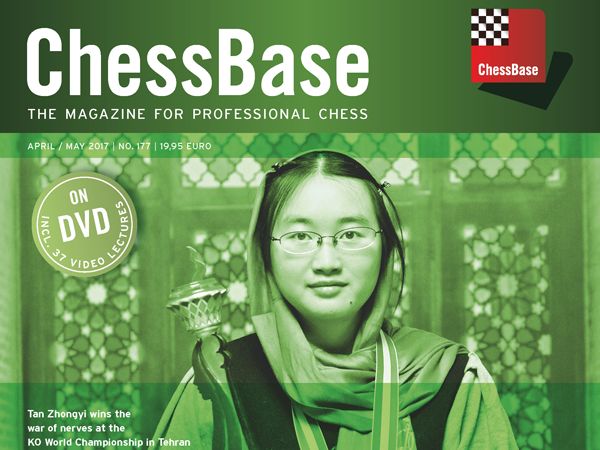



















 The editor’s top ten
The editor’s top ten















